March 23, 2025
In July 2024, I talked about Geodrill (GEO.TO / GEODF). But Geodrill’s situation has significantly improved since then, so I am going to update the investment thesis.
Geodrill is a leading drilling services provider focused on gold (90%+ of revenue) and other mineral exploration for major, intermediate, and junior mining companies across Africa and South America. Founded in 1998 by CEO Dave Harper—who still owns over 40% of the company—Geodrill has grown organically from one rig in 1998 to 102 rigs today, with operations in six countries—Cote d’Ivoire, Senegal, and Mali in West Africa; Egypt in North Africa; and Peru and Chile in South America.
The company is known for its quality and long-standing relationships with top-tier clients like Barrick, Newmont, and Kinross. It has successfully shifted its customer base toward senior miners (now ~90% vs. 70% previously) and more stable jurisdictions, securing multi-year contracts worth ~$200 million, providing visibility through 2027.
With gold prices now exceeding $3,000/oz, miners are reinvesting heavily, benefiting Geodrill’s growth prospects. Harper is seeking a sale at 5x EV/EBITDA, valuing the stock at $4.13—more than double its current price of $2.02.
Geodrill reinvested every penny of operating cash flow into expanding their fleet in the most recent year.
On the most recent earnings call, CEO Dave Harper pointed out that the company has been growing on average about 10% a year over the last 8 years. Harper said of course the company would encounter challenges—there are always challenges—but that growth should be at least 10% a year going forward (if not more, given gold prices over $3,000 an ounce).
Harper said, “We’ve never been more bullish, never been more bullish, never been more bullish.”
Harper notes that the company drills in locations where gold is heavily mined, where it’s relatively easy to mine, but where other people don’t want to mine.
Harper pointed out the company is “really going to shine over the next four years. This will become a cash cow, mark my words.”
The market cap is $94.8 million while enterprise value is $86.7 million.
Here are the metrics of cheapness:
-
- EV/EBITDA = 2.69
- P/E = 8.03
- P/B = 0.79
- P/CF = 4.52
- P/S = 0.67
Geodrill’s metrics of cheapness are exceptionally low.
The company is planning to pay a dividend again—likely $0.01 per quarter this year and a larger dividend in 2026.
As noted, CEO and founder Dave Harper owns 40%+ of the shares. ROE (return on equity) is 7.9%. This is a bit low but will move higher because margins should continue to improve, given high gold prices.
Cash is $19.5 million while debt is $11.4 million. TL/TA is 26%, which is excellent.
Intrinsic value scenarios:
-
- Low case: If there’s a bear market or a recession, the stock could decline temporarily. This would be a major buying opportunity.
- Mid case: As noted, Dave Harper owns 40%+ of the shares and is looking to sell at 5x EV/EBITDA. This would mean a stock price of $4.13 per share, which is over 100% higher than today’s $2.02.
- High case: EBITDA could reach $50 million by 2027. At an EV/EBITDA of 6x, the stock would have an intrinsic value of $6.04, about 200% higher than today’s $2.02.
RISKS
-
- As noted, if there’s a bear market or a recession, the stock could decline temporarily. This would be a major buying opportunity.
- Gold prices may fall.
- There could be political instability in Africa or in Peru/Chile. This has rarely been an issue for the company in the past.
BOOLE MICROCAP FUND
An equal weighted group of micro caps generally far outperforms an equal weighted (or cap-weighted) group of larger stocks over time. See the historical chart here: https://boolefund.com/best-performers-microcap-stocks/
This outperformance increases significantly by focusing on cheap micro caps. Performance can be further boosted by isolating cheap microcap companies that show improving fundamentals. We rank microcap stocks based on these and similar criteria.
There are roughly 10-20 positions in the portfolio. The size of each position is determined by its rank. Typically the largest position is 15-20% (at cost), while the average position is 8-10% (at cost). Positions are held for 3 to 5 years unless a stock approachesintrinsic value sooner or an error has been discovered.
The mission of the Boole Fund is to outperform the S&P 500 Index by at least 5% per year (net of fees) over 5-year periods. We also aim to outpace the Russell Microcap Index by at least 2% per year (net). The Boole Fund has low fees.
If you are interested in finding out more, please e-mail me or leave a comment.
My e-mail: jb@boolefund.com
Disclosures: Past performance is not a guarantee or a reliable indicator of future results. All investments contain risk and may lose value. This material is distributed for informational purposes only. Forecasts, estimates, and certain information contained herein should not be considered as investment advice or a recommendation of any particular security, strategy or investment product. Information contained herein has been obtained from sources believed to be reliable, but not guaranteed.No part of this article may be reproduced in any form, or referred to in any other publication, without express written permission of Boole Capital, LLC.

